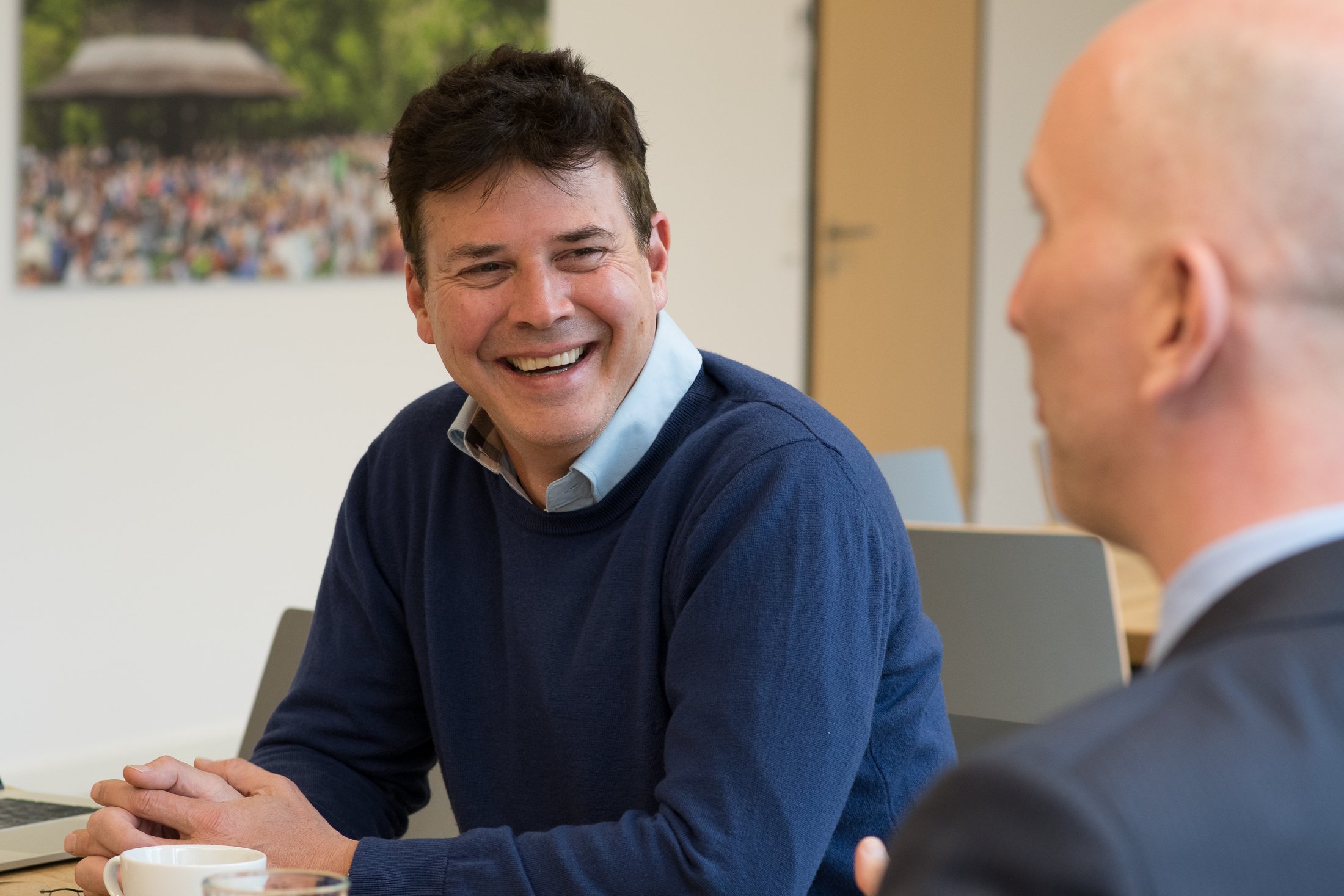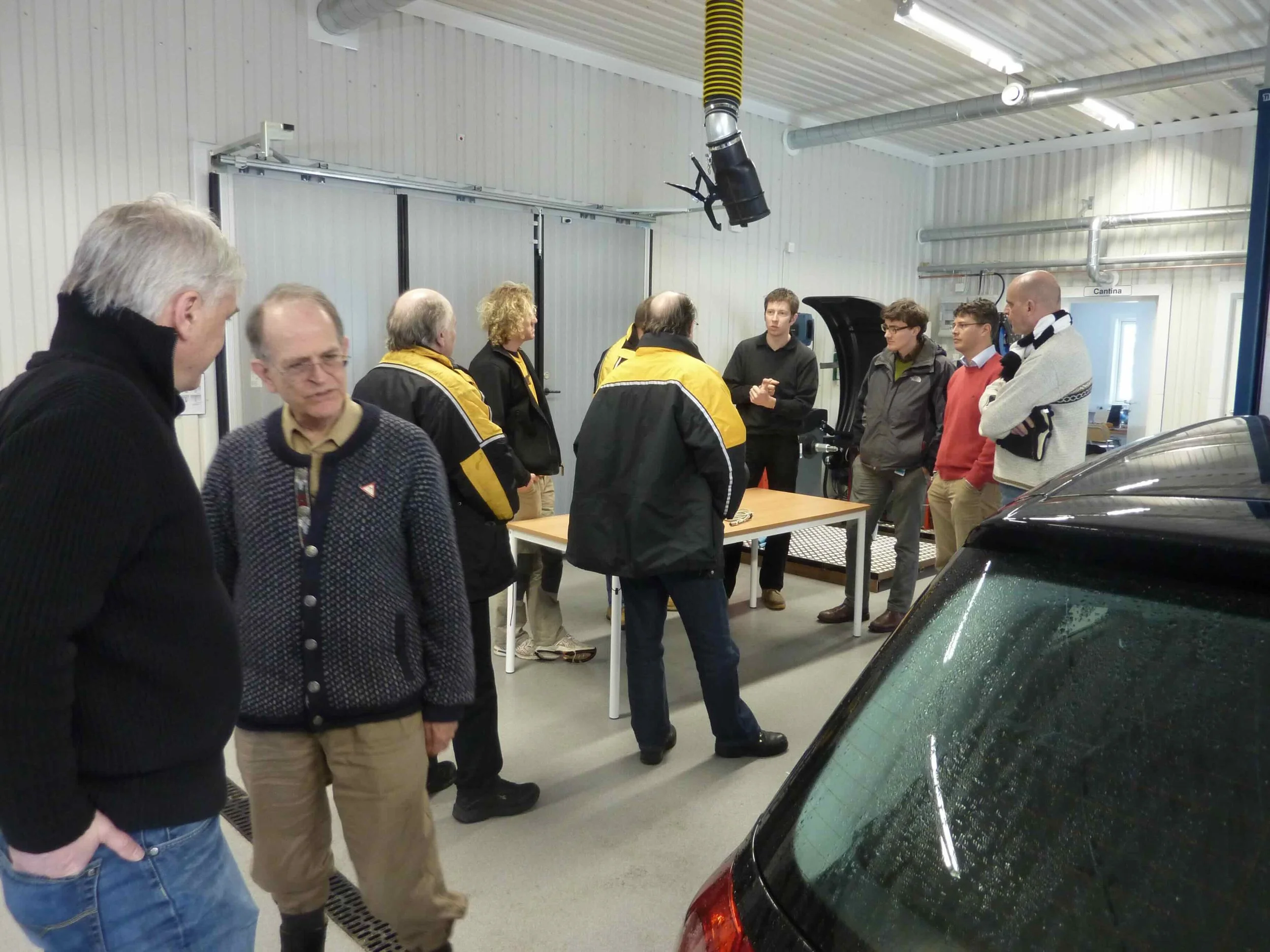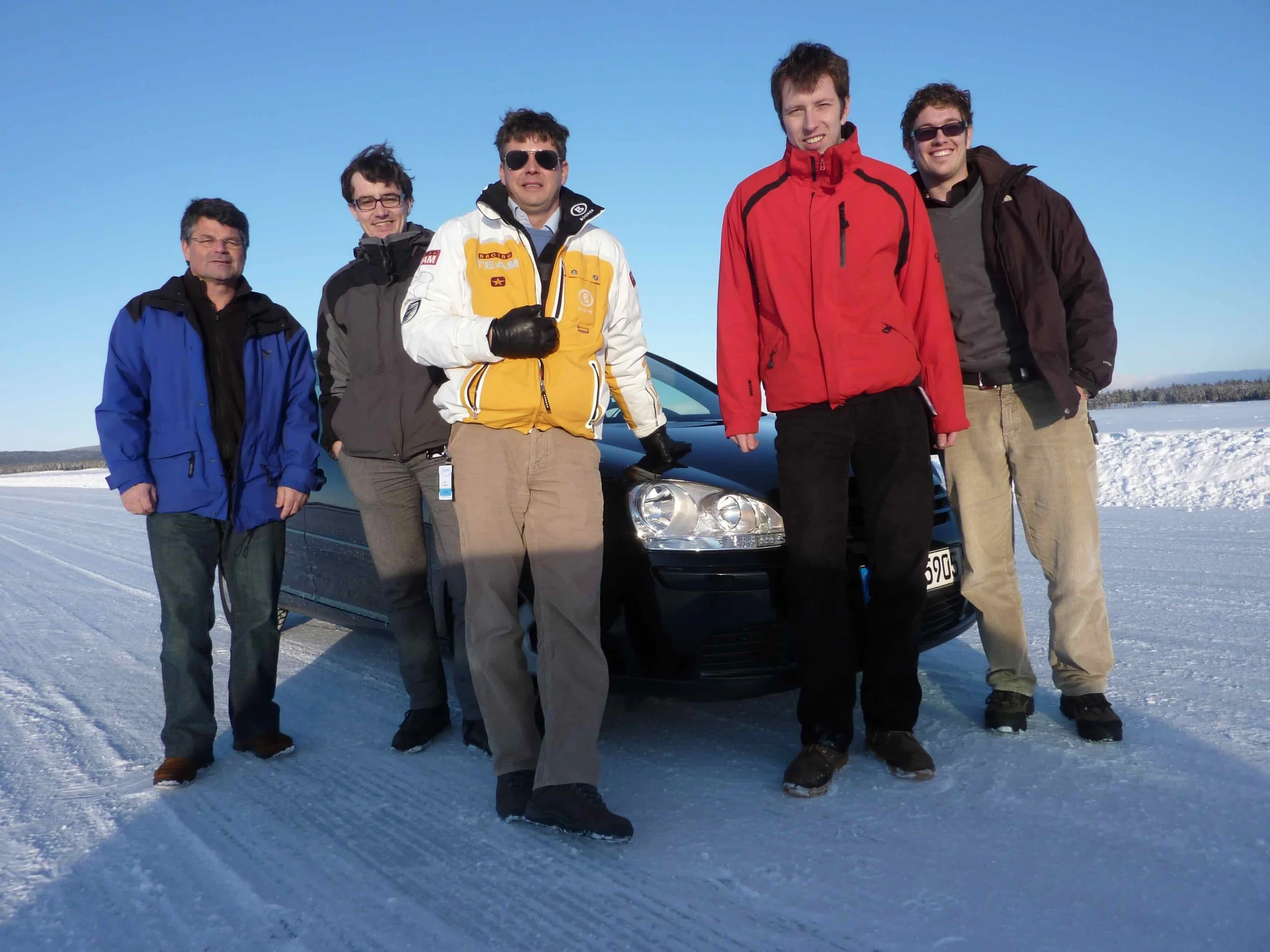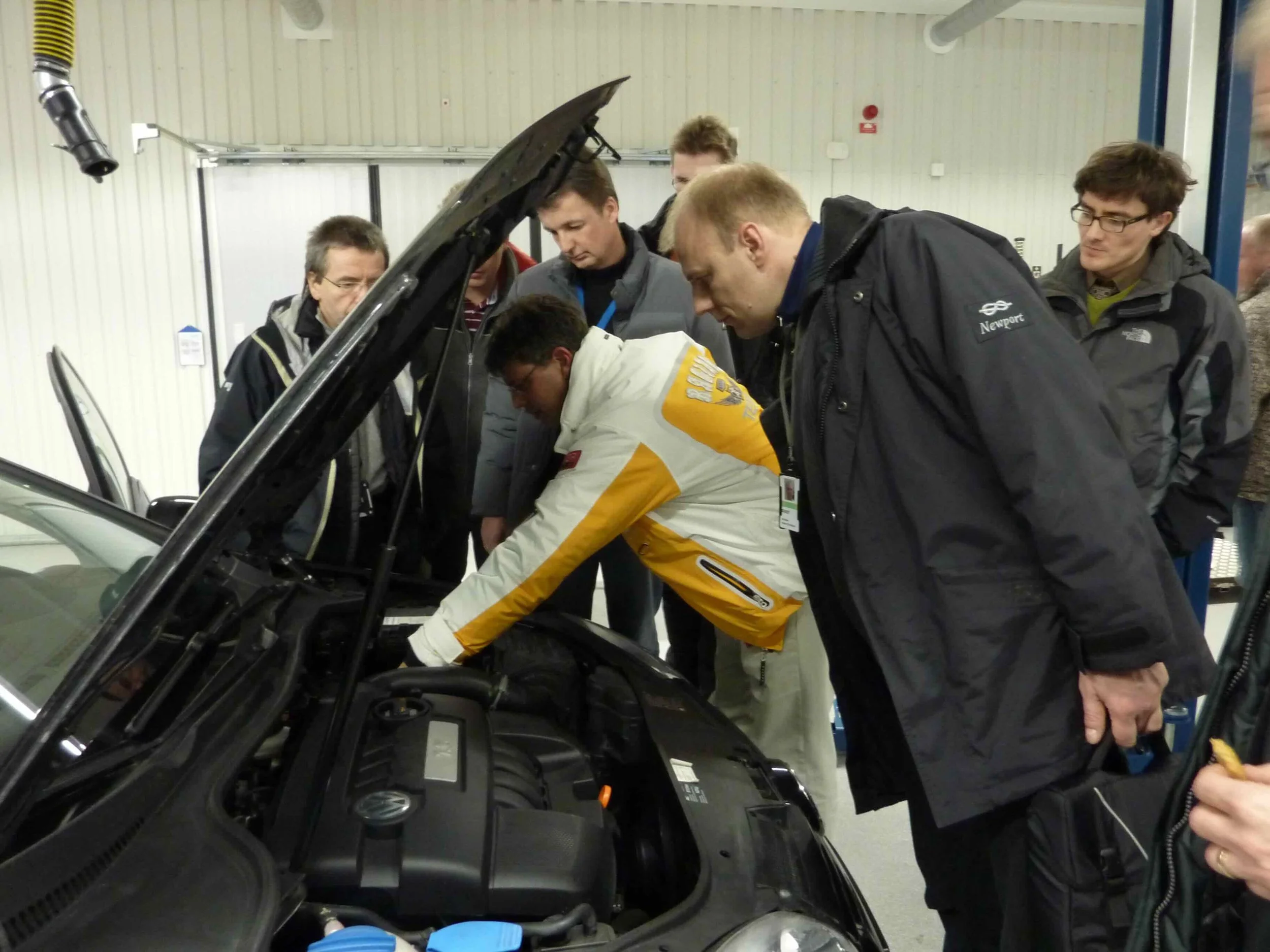
How Do Things That Can Change the Way We Live Come Into Being?
The Pioneers of the One-Box Brake System
Disclaimer: The views and opinions expressed in this article are those of LSP and IPGATE AG. Statements made by Dr. Hans-Jörg Feigel are his personal views and do not necessarily represent the official position or views of Continental.
Introduction
We often go about our daily lives relying on technology, rarely stopping to consider the brilliant minds behind the conveniences we take for granted. From the devices in our homes to the systems in our cars, countless innovations shape our world.
Have you ever paused to think about the engineers working on small yet potentially game-changing components that could soon revolutionize your driving experience? It's easy to overlook the complex engineering that ensures everything in our car works seamlessly, but behind these advancements are talented individuals whose dedication and ingenuity are shaping the future of automotive technology.
Innovation doesn’t happen overnight. It’s fueled by curiosity, intelligence, and the relentless drive to fail—and try again—until something truly groundbreaking emerges, or like Dr. Anton van Zanten likes to say: "Innovation isn’t about waiting for the perfect moment; it’s about recognizing when an idea could work and pushing forward to make it a reality, even if others are still figuring it out."
While most are familiar with major automotive milestones like the invention of the wheel, the combustion engine, or even electric cars - by the way, did you know that Nikola Tesla laid the groundwork for the electric motor as early as 1887? - there’s a lesser-known yet life-saving innovation already present in one in every three cars on the road: the brake-by-wire One-Box system.
This article is dedicated to the pioneers - the engineers of IPGATE, LSP and Continental - whose innovations are the building blocks of the One-Box fail-safe brake-by-wire systems (Integrated Brake System Technology, IBS-Technology, MK C1 Technology) and Two-Box fail-operational brake-by-wire systems (X-Boost TechnologyTM) as we know them today.
Dr. Anton van Zanten
Dr. Anton van Zanten
Dr. Anton van Zanten, a Dutch inventor and automotive engineer born in Indonesia in 1940, is renowned world-wide for his contributions to vehicle safety technology. After moving to the Netherlands at age 10, he studied in Eindhoven for an MSc and earned a PhD from Cornell University, USA. He joined Robert Bosch GmbH in Germany in the 1970s. There, he proposed and led the development of the Electronic Stability Program (ESP/ESC), introduced in 1995 on the Mercedes-Benz S600, which greatly improved vehicle safety.
Van Zanten holds around 180 patents, with 36 focused on automotive safety, including electronic rollover and trailer sway mitigation. He also served as a consultant to IPGATE AG for several projects. Though retired in 2003, he continued to lecture at Universities, OEMs and in industry and consult in the field. His groundbreaking work earned him among many others the 2016 European Inventor Award in the Lifetime Achievement category and together with Armin Müller of MB the Porsche Prize and the Golden Dieselring.
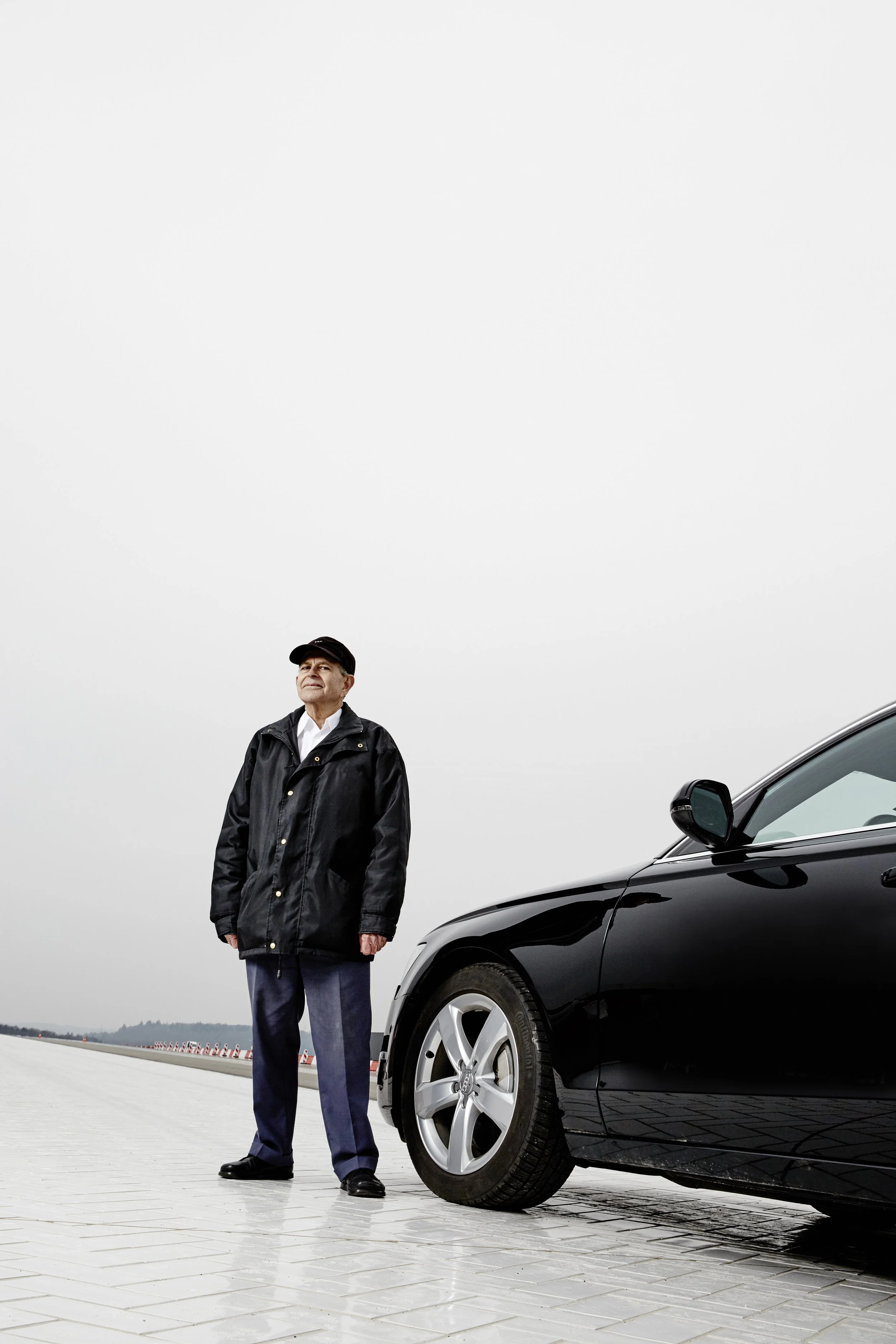
"Innovation isn’t about waiting for the perfect moment; it’s about recognizing when an idea could work and pushing forward to make it a reality, even if others are still figuring it out."
— Dr. Anton van Zanten
Established in 1998 by Dr. Thomas and his father, Heinz Leiber, LSP Innovative Automotive Systems GmbH is a boutique engineering service with extensive experience in supporting clients to integrate technology solutions into their products efficiently and cost-effectively.
Dr. Thomas Leiber established IPGATE AG in 2005. As a leader in brake systems and vehicle motion control, it offers patented technology and freedom to operate rights for vehicle technology for cutting-edge vehicle solutions. These include eMobility, autonomous driving, ePedal, and single-source chassis control systems, all developed by a team of seasoned engineers.
Since its establishment, IPGATE AG has been collaborating with LSP Innovative Automotive Systems GmbH to offer comprehensive services to its clients.
Continental AG, founded in 1871 in Hanover, Germany, started as a rubber manufacturer under the name Continental-Caoutchouc und Gutta-Percha Compagnie. Over the years, it evolved into a leading producer of tires and automotive technologies, pioneering innovations like grooved vehicle tires and air springs. In 1998 Continental took over the brake specialist Alfred Teves GmbH, which was founded in 1906 and was one of the pioneers in Integrated ABS-Systems (1984).
Today, Continental is a major player in the automotive industry, offering products ranging from safety systems to solutions for automated driving, connectivity, and sustainable mobility. With around 200,000 employees worldwide, the company remains a driving force in automotive innovation.
Introducing the One-Box
Imagine you’re rushing down a winding country road, already running late for an important meeting. You’re driving 100 km/h—maybe 20 km/h over the speed limit—because you just don’t have time to slow down. Your mind is preoccupied, ticking off tasks for the day, deadlines looming over you. The hum of the electric motor and the smooth drive almost put you into a trance.
Suddenly, out of the corner of your eye, you see movement. You turn your head, and your heart stops. A deer is darting across the road—right in front of your car.
Panic surges through you. You slam your foot on the brake, but it’s clear: you only just noticed the deer. You don’t have much time.
But then, something incredible happens.
Your car, equipped with the advanced One-Box electrohydraulic power-on demand braking system (short: One-Box EHB), springs into action the moment you apply the brakes. It’s almost like the car anticipates your panic. The One-Box builds brake pressure at a speed that’s almost impossible to comprehend—achieving up to 1 G (9,81 m/s2) of deceleration in less than 150 milliseconds. The car responds before you even have a chance to fully process what’s happening
As you feel the car’s grip tighten on the road, you realize the One-Box EHB has already cut down your braking distance significantly. Even though you were speeding, it’s doing everything it can to bring you to a stop as quickly and safely as possible.
But here’s where the technology really shines. The One-Box EHB isn’t just fast—it’s reliable, even if something were to go wrong. The system is built with fail-safe mechanisms to ensure you’re always covered. It uses dual microcontroller units (MCUs), meaning if one controller fails, the other will immediately take over. There’s also a redundant Electronic Parking Brake (EPB) control that kicks in, adding another layer of security.
Even with the deer so close, you don’t need to worry. The system is working in the background, and it’s able to switch between master and slave control systems if needed. The car is decelerating, hard and fast, and the situation feels much less dire now.
Thanks to the One-Box’s EHB advanced automatic emergency braking (AEB) system, you’re able to stop just inches from the deer. It bounds away into the woods, blissfully unaware of how close it came to disaster.
You sit there for a moment, your heart still racing, as you realize just how lucky you are. That close call could’ve been a lot worse if not for the One-Box and its fail-safe features. You can’t help but appreciate the safety technology that just kept you from a potential catastrophe.
With all its redundant systems, energy-efficient braking, and rapid response, the One-Box EHB is working seamlessly to ensure your safety, no matter how distracted or in a rush you might be.
Who are the pioneers behind the One-Box in its early form?
Many readers may recognize the Anti-lock Braking System (ABS), first introduced in the 1978 Mercedes-Benz S-Class—a groundbreaking achievement by Heinz Leiber, who played a pivotal role in innovating, developing, and bringing the first generation of ABS (ABS 2.0) to series production at Robert Bosch GmbH. Similarly, Dr. Anton van Zanten, also at Bosch in the 1980s, developed the famous Electronic Stability Program (ESP/ESC). It’s no surprise that these visionary engineers, leveraging their expertise in automotive safety, also contributed significantly to the development of the One-Box EHB, furthering their legacy of pioneering innovations.
Heinz Leiber & Dr. Anton van Zanten testing the Mercedes-Benz S-Class ©press-informHeinz Leiber
Heinz Leiber
Heinz Leiber is a renowned German inventor and automotive engineer, best known as a key inventor of the Anti-lock Braking System (ABS), a life-saving technology introduced in the 1978 Mercedes-Benz S-Class. Starting his career at Teldix and later at Robert Bosch GmbH, Heinz Leiber played a pivotal role in the innovation and launch of ABS 2.0, later serving as Vice President of Mercedes-Benz AG's Electrics/Electronics Division. With 589 patent families, including 396 related to brakes, Leiber's influence extends beyond ABS to designing the E/E Multi-BUS architecture and shaping future mobility concepts.
Heinz Leiber has received numerous awards, including the Federal Cross of Merit and the Porsche Prize.
Yet, the journey began with
Dr. Thomas Leiber, Heinz’s son, who invented an extremely dynamic electric motor with a high torque and low motor inertia, a so-called dual air-gap (DAG) motor design that could accelerate to 3000 rpm in just
3 milliseconds – a technology enabling component at the beginning of the invention of the One-Box EHB.
Dr. Thomas Leiber
Dr. Thomas Leiber
Dr. Thomas Leiber is a pioneering innovator and entrepreneur in automotive technology, holding nearly 500 patents in areas such as braking systems, vehicle safety, and autonomous driving. He earned a degree in Aerospace Engineering from the Technical University of Berlin and a doctorate in Electrical Engineering from the Technical University of Graz, further enhancing his expertise with a post-doctoral stint at MIT.
Dr. Leiber's key innovations include the IBS Technology and later the X-Boost Technology ™, designed to replace 2-box braking systems and enhance autonomous driving, and the IBSe (Intelligent Braking System), introduced in Formula E racing. He also pioneered Automated Emergency Braking (AEB) and developed a drive system for electric vehicles, anticipating the shift towards electric propulsion.
Dr. Leiber has received numerous accolades, including the Wirtschaftswoche Top25 Start-Up Award and the CleanTech 100 Award, as well as the Plus X Award for innovation, design, and functionality.
Dr. Thomas Leiber sharing personal and professional moments with his father Heinz Leiber“MK C1/IBS the pioneering product of the One-Box EHB, as we know it today – was the result of a unique collaboration between my father and me, combining his extensive knowledge and experience in car brake system technology with my early innovations in my professional career. During a five-year collaboration with Magneti Marelli and Volkswagen on electric valve train actuation, along with my doctoral thesis work, I gained in-depth experience with electromagnetic actuators and advanced EC motor control. It was during this time that I discovered the potential of the double air gap motor design for dynamic and precise control.
I shared the full potential of this motor with my father, and he immediately saw an opportunity to bring to life an idea that had previously seemed impossible. Previous attempts, such as the first one-box ABS 3, were limited in functionality. What my father recognized was that this motor, driving a plunger, could integrate multiple functions—such as brake force boosting, pressure modulation for ABS, and precise pressure control for regenerative braking—into a single system, reducing the number of components needed.
It’s like a computer processing multiple tasks at once: while not simultaneous in the strictest sense, the tasks are completed incredibly quickly—one after another. This speed and dynamic response from the motor were essential to making it work. This was the foundation of the first generation of the integrated brake system (One-Box EHB, also known as IBS Technology).” – Dr. Thomas Leiber

"I shared the full potential of this motor with my father, and he immediately saw an opportunity to bring to life an idea that had previously seemed impossible."
— Dr. Thomas Leiber
Getting a
Big Player on Board
Father and son quickly realized that bringing their vision to life would require more than just their combined knowledge and experience. To truly make their idea a reality, they needed the expertise of someone with a deep understanding of the Electronic Stability Program (ESP/ESC)—a key component in modern automotive safety. Of course, the only person who came to mind was the trusted Dr. Anton van Zanten, who had previously been hired by Heinz Leiber while working at Bosch and was easily convinced to join the team.
Dr. van Zanten’s specialized knowledge of control functions complemented Heinz Leiber’s extensive experience in brake systems and Dr. Thomas Leiber’s expertise in electric motors, creating a powerful and dynamic partnership.
With the team now in place, Dr. Thomas Leiber recruited two talented engineers, Christian Köglsperger and Valentin Unterfrauner, who were working at LSP at the time. Together, father and son decided to formalize their groundbreaking concept by filing the first patent families in 2005 for what would later become known as the first patent members of the comprehensive IP portfolio A of IPGATE AG, constituting the IBS technology.
As Dr. van Zanten recalls, “From the simulation models to the real-world tests, we quickly realized the potential. We knew we had developed something that not only worked but could set a new standard in vehicle safety.”
Christian Köglsperger & Valentin Unterfrauner
Christian Köglsperger & Valentin Unterfrauner
Christian Köglsperger is an electrical engineer known for his contributions to advanced braking technologies. As a co-inventor of several IPGATE AG patents, he has played a key role in developing one-box and two-box brake systems, significantly influencing braking solutions. His work has been instrumental in shaping brake-by-wire systems for concept vehicles and racing applications, particularly in Formula E.
Previously, Köglsperger served as COO at LSP Innovative Automotive Systems GmbH, where he contributed to the development of cutting-edge braking technologies. His innovations have been featured in technical publications, showcasing his expertise in next-generation braking systems.
Valentin Unterfrauner is a skilled automotive engineer and innovator known for his contributions to advanced braking technologies. He is the former head of pre-development at LSP Innovative Automotive Systems GmbH and significantly contributed to various patents for IPGATE AG, focusing on one-box and two-box brake technologies, which are critical advancements in modern automotive engineering.
His expertise lies in developing innovative solutions for eMobility, autonomous driving, ePedal systems, and single-source chassis control. Unterfrauner's work supports the creation of cost-effective, sustainable, and future-proof braking systems, helping manufacturers integrate cutting-edge technology into their vehicles.
Rather than immediately investing time and resources into building a complex prototype, the team decided to leverage their strong industry reputation and credibility. Though the initial concept appeared overly simplistic to some, the basic prototype they created at LSP was enough to showcase its potential and convince their partners of its promise. The team’s confidence grew, and they knew they were on to something special.
Thanks to Heinz Leiber’s industry connections to Dr. Karl-Thomas Neumann, who was the former acting CEO of Continental Automotive Systems from 2004-2009, the team had the opportunity to present the innovation to Continental in October 2005 and shortly after met with Dr. Hans-Jörg Feigel in June 2006, who would later become a crucial ally in championing the project.
Valentin Unterfrauner recalls, “When we presented our idea to one of the other key Tier 1 manufacturers previously, we faced a lot of resistance. In the end, it was at Continental, with Dr. Hans-Jörg Feigel's backing, where we really saw the potential for growth. He understood the value of our work and pushed for the support we needed.”

"Dr. Hans-Jörg Feigel really saw the potential for growth. He understood the value of our work and pushed for the support we needed."
— Valentin Unterfrauner
Dr. Hans-Jörg Feigel
Dr. Hans-Jörg Feigel
Dr. Hans-Jörg Feigel is a mechanical engineer with over 30 years of experience in braking systems, chassis technologies, and autonomous mobility. After earning his doctorate from RWTH Aachen University in 1991, he began his career at ITT Automotive, focusing on suspension control and anti-lock braking systems.
Dr. Feigel spent nearly 25 years at Continental in different management positions; among other things, he was responsible for developing the MK C1 brake-by-wire system, the first integrated brake system, which finally entered series production with Alfa Romeo in 2016.
From 2015 to 2021, Dr. Feigel was Vice President at Mando Corporation in South Korea and later President of Mando Europe GmbH. Mando is a leading automotive supplier of chassis, products and autonomous driving with HQ in Korea.
In 2021 Dr. Feigel returned to Continental as Senior Vice President Strategy and Innovation for Safety and Motion. There, he was responsible for dry brake-by-wire systems development and initiated also the collaboration with the tech company DeepDrive for creating an eCorner-System based on a new double radial flux in-wheel motor with integrated brakes (drive-brake unit).
Since 2024, Dr. Feigel has been the Managing Partner at INFINITI GmbH, focusing on innovation and strategic consulting in the automotive sector. His career reflects a deep commitment to advancing vehicle safety and mobility solutions globally.
The patents
behind the story
Explore the patents by clicking the links below (representative patent family members)IPGATE
Early phase IBS 1 (2005-2009)
-
Piston pressure control, MUX, time-to-lock in 50 ms, master cylinder design with small diameter difference.
-
Variable pre pressure and pressure gradient control with pressure-volume characteristic curve
-
Brake lining clearance control with vacuum (0.5 bar) for friction reduction by piston and valve control
-
Simultaneous and partially simultaneous pressure increase and decrease using 2/2 switching valves
IPGATE
Final phase IBS 1 (2010-2012)
-
Brake-by-wire design with elastomer travel simulator and diagnostic inlet valve
-
Sensors with direct contact on circuit board for motor sensor, pedal travel sensor and level sensor
-
Parallel arrangement of master cylinder, pressure supply unit and travel simulator in closed loop
CONTINENTAL
MK C1 Development (2010-2013)
-
Pressure control using piston speed and fast replenishmen
-
Vehicle stabilization and BCI Function – Brake Curve Intervention
-
Packaging: Standard for most 1-box brake systems
-
Simultaneous and partially simultaneous pressure increase and decrease using 2/2 switching valves
-
MKC1: Final design with pressure calibration procedure
-
Wheel-selective pressure control using pressure-volume curve
-
Management strategies for optimal regenerative braking
Dr. Hans-Jörg Feigel, for his part, remembers the first meeting with LSP well. “The first contact with the LSP team was when they showed us an electric motor with a dual air-gap design. At that time, we had already pre-developed a brake system with three plunger actuators, which served normal brake actuation and slip control functionalities for each front wheel brake and the rear axle brakes. A brushless motor and a ball screw drive drove each piston-cylinder unit. It worked well, but it was complex, with three motors, gears, electronics, and position sensors. While effective and precise, it was expensive. If we could adopt a multiplex approach with fewer motors and pumps, it would be more affordable. Then, Thomas approached us with their idea, which seemed to address exactly this problem. I went to Munich in June 2006, and they demonstrated their system on a test bench. It was impressive. After that, we decided to move forward with a study to explore its potential.”
“They were on the crusp of creating something that could reshape the future of automotive safety.”
- Dr. Hans-Jörg Feigel
With the support of Dr. Hans-Jörg Feigel and Continental, the project began to gain the momentum it needed. The team knew they were no longer just dreaming—they were on the cusp of creating something that could reshape the future of automotive safety.
IPGATE and LSP team together with Continental team in SwedenBringing the Vision to Life: Two Perspectives on Innovation
The journey to turning an innovative concept into a viable product was far from straightforward. Dr. Thomas Leiber and his team faced a pivotal challenge: proving the feasibility of their idea in a real-world environment. To do this, they arranged to test their system at a track in Sweden, a place where they could demonstrate its functionality under practical conditions. But even with this hands-on testing, the real hurdle wasn’t just proving that the system worked; it was convincing others of its value when most people didn’t fully understand it. As Dr. Leiber put it, “Imagine selling a box of chocolates without revealing what was inside.” This analogy captured the essence of their challenge: how do you sell an abstract concept that seems unfamiliar and hard to visualize? Despite the doubts and uncertainty surrounding the technology, the team firmly believed in their innovation and managed to convince others of its potential, setting the stage for what would become a game-changing advancement in automotive safety.
Dr. Thomas Leiber, Dr. Hans-Jörg Feigel, Valentin Unterfrauner, Christian Köglsberger und Franz Schöglmann on test track in Sweden Meanwhile, Dr. Hans-Jörg Feigel at Continental also faced his own set of obstacles. The approach from LSP wasn’t simply about using a high-dynamic motor—it also involved incorporating an ABS functionality that had to meet the benchmark of brake distance of ABS systems that were on the market since 1978. Continental already had experiences with similar systems in the late '80s, such as the so-called VacMux System, which realized an ABS control by an electro-pneumatic valve-controlled vacuum booster that moved the master brake cylinder back and forth to connect through multiplex on/off-valves the different wheel brakes according to the demands of an electronic slip controller. While the system had functioned well in theory, it was slow, and there had been a history of disappointing results with this similar technology. Some within Continental had worked on earlier experiments and found them lacking performance. Convincing these skeptics to give it another try with a highly dynamic e-motor wasn’t easy.
“We had to convince the skeptics that it was worth trying again,” Dr. Hans-Jörg Feigel explained. “Despite the resistance, the team at Continental recognized the potential of the new system, and the decision was made to move forward with development, starting with a Volkswagen Golf. As the team began to implement the multiplex system, we worked on optimizing the ABS-control and conducting focused tests to demonstrate its potential, particularly to those who were initially doubtful.”
Dr. Thomas Leiber and team inspecting the prototype in a test vehicle“Physically, you can’t have two components in the same place at the same time,” Dr. Feigel noted, underscoring the practicality of the technology. While the results didn’t fully meet the high expectations of some colleagues, they were enough to spark real interest and show that this technology had the potential to work. This led to a major breakthrough—Continental decided to consolidate the collaboration with an agreement between the three parties, Continental, LSP and IPGATE AG, securing access to the promising new technology for future use. The road ahead was still long, but with their technology now validated and supported by some of the biggest names in the industry, the team was finally on the path to making their vision a reality.
A Team on
Snow and Ice
Turning a groundbreaking idea into reality was no easy task. As Christian Köglsperger aptly put it, "It’s one thing to come up with ideas; it’s another to get them off the ground. In big projects, you can’t afford endless discussions. You need to get to work and demonstrate the basic principles, then surround yourself with the people who will push it forward." This practical mindset was at the heart of the One-Box project, which ultimately succeeded due to the dedication and expertise of a diverse team.
From the outset, Dr. Thomas Leiber had great confidence in his team. "I told them, ‘Just go ahead, you’ve got this. I trust you.’ None of us knew exactly how to build a car or install a new braking system, but I had full confidence in their abilities." This trust was fundamental to the project’s success, fostering a sense of autonomy and responsibility within the team. As the team worked through the complexities of their innovative system, the contributions of each member proved to be crucial.
Christian Köglsperger fondly recalled, "I remember when we first put the prototype brake system in a car. After Van Zanten fixed the software, Heinz said, 'Let’s take it for a spin.' I told him, 'I don’t think we’re ready for the public streets just yet!' But Heinz, being Heinz, just got in, I hopped in the passenger seat, and he drove straight at a wall at high speed to test the brakes. My adrenaline was definitely up, and I’m just relieved the brakes worked!"
“I’m just relieved
the brakes worked!"
A key figure was Dr. Anton van Zanten, whose expertise in the Electronic Stability Program (ESP/ESC), in particular with his vast software and functional knowledge, proved critical to the team’s work. Dr. Thomas Leiber called him "the key connector for everything." Despite facing personal challenges, including his inability to fly, Dr. Van Zanten remained committed to the project, driving two days to Sweden for testing by train—famously losing his laptop on the return journey. "That’s how committed he was to the team and the project," Dr. Thomas Leiber remembered with a chuckle.
Testing in Sweden became a defining moment for the project. As Christian Köglsperger vividly recalled, "Testing with Continental in freezing temperatures on frozen lakes was brutal, but it proved something crucial: the principles we were developing worked. The cold and harsh conditions didn’t stop us from pushing boundaries."
The snowy, icy track in Sweden became the perfect testing ground for their braking system, providing the harsh conditions necessary to prove the system's viability. Without access to high-end test facilities, the team made do with alternative testing locations, taking full ownership of the process. Dr. Leiber remarked, "We didn’t have a fancy test facility like the big companies, so we made use of other testing locations."
Dr. Thomas Leiber explaining the system The excitement surrounding the tests was palpable, not just because the technology worked, but because of the energy and enthusiasm the team brought to the project. Dr. Leiber observed, "When we showed up, people would always gather around and want to join in on the ride." This infectious energy created an emotional connection to the technology, making the testing process not just a technical achievement but a shared experience for everyone involved.
“If this works, I'll buy
you a bottle of Sekt.”
Dr. Anton van Zanten fondly remembered the first successful test at Continental, stating, "I’ll never forget the first test of our device at Continental—it worked perfectly right out of the gate. I told Köglsperger, 'If this works, I'll buy you a bottle of Sekt,' and it was one of those moments where we knew we were onto something special." The success of that first test marked a significant milestone in the project, confirming that the team had, indeed, developed something game changing. This moment of triumph further solidified the team’s confidence in their vision, pushing them closer to the realization of their groundbreaking technology.
Innovating together and in parallel
While the external team of LSP focused on the dual air-gap motor and the multiplex system of the IBS, Dr. Hans-Jörg Feigel and his team worked on a parallel development track, honing their approach to vehicle safety. "We were also developing the MK100 project at the same time," Dr. Hans-Jörg Feigel explained. The future brake system development team, led by Steffen Linkenbach in Dr. Peter Rieth’s advanced development area, shifted the focus toward pressure increase and reduction using a central actuator without relying on the dual air-gap motor and multiplex valves. While the internal system functioned well, it wasn't cost-effective enough for mass production in its current form.
Resistance within Continental presented another significant challenge. Most were skeptical about a second try to introduce a pedal simulator brake system after the Bosch-SBC-System failed at Mercedes in 2004. "Also, introducing design changes to improve the conditions for mass production was not easy to achieve as some people wanted to keep the development risks low." Dr. Hans-Jörg Feigel recalled, referring to the decision to replace a complex and less compact belt drive with a direct drive between the electric motor and the ball screw. The shift in direction was not easy, and internal skepticism made it even harder to push forward. However, Dr. Hans-Jörg Feigel’s determination to bring the technology to life was unwavering, and the development team grew fast. Jan Hoffmann was responsible for the system team, Peter Drott for Design, Dr. Christian Beier-Welt for e-Drive, Josko Kurbasa for Electronics, Peter Olejnik for Controls, Jens Jäger for vehicle Test and Steffen Linkenbach, later also Stefan Straßburger for Project Management.
Through rigorous testing and persistence, this excellent team successfully addressed technical challenges, such as integrating the brake cylinder into the valve block and finding a cost-effective way to integrate the actuator cylinder.
The "Not Invented Here" mindset within the company also created barriers, as some were reluctant to adopt ideas coming from external teams. But despite these obstacles, Dr. Hans-Jörg Feigel and his team persevered. "At that point, we were truly the pioneers in introducing this technology in its specific form. While the concept wasn’t entirely new, the way we constructed it was a completely fresh approach." This fresh approach was unveiled to the world at the 2013 Frankfurt Motor Show, where it received an overwhelmingly positive response. "The buzz it generated was incredible, attracting customers—even from our competitors," Dr. Hans-Jörg Feigel recalled. He remembered one of their main competitors sending dozens of engineers, some to measure the dimensions of the product, even though it was still in the early stages of development. "The product wasn’t even fully finished, and we weren’t sure we could even fit all the necessary holes in the valve block, but we stuck to the dimensions as planned.", Dr. Hans-Jörg Feigel recalls with a chuckle.
Testing on snow and ice in Sweden
This exposure was more than just a show of confidence in the technology—it was a deliberate strategy to engage the market. "It was so new and innovative, and we wanted to hear directly from the market. We needed feedback to understand how far customers were willing to go in integrating such a system." That feedback not only validated the project but also pushed it forward within their management teams. The response at the Frankfurt Motor Show was so strong that it made competitors sit up and take notice. Dr. Hans-Jörg Feigel recalled.
But even though a lot of OEMs (Original Equipment Manufacturers) showed high interest, the fear of taking risks by introducing this new brake technology as a pilot customer was very high. It took a lot of design reviews, safety audits, prototype build-ups and fallback mode evaluations to convince the responsible people at the customers. The real breakthrough came when Philippe Krief, the former development head at Alfa Romeo and Ferrari, made the bold decision to adopt the technology for a tight timeline project at Alfa Romeo. "Once he decided, we had to quickly kick off the industrialization process," Dr. Hans-Jörg Feigel recalled. This decision marked a turning point, not only giving the technology credibility but also demonstrating its potential to the wider industry. With Alfa Romeo and later BMW on board, the project gained momentum. Despite facing internal resistance, the project began to move forward rapidly. "The customer’s decision always triumphs," Dr. Hans-Jörg Feigel noted, underscoring the importance of having strong support from key customers to drive the technology to success.
Thanks to the commitment of Dr. Hans-Jörg Feigel and his team, the project broke through the barriers that had once seemed insurmountable. Their unwavering belief in the technology and ability to navigate internal resistance was crucial to its success. With major OEMs backing the project, the innovative system was no longer just a promising concept—it was on the verge of becoming a new brake system standard in the automotive industry.
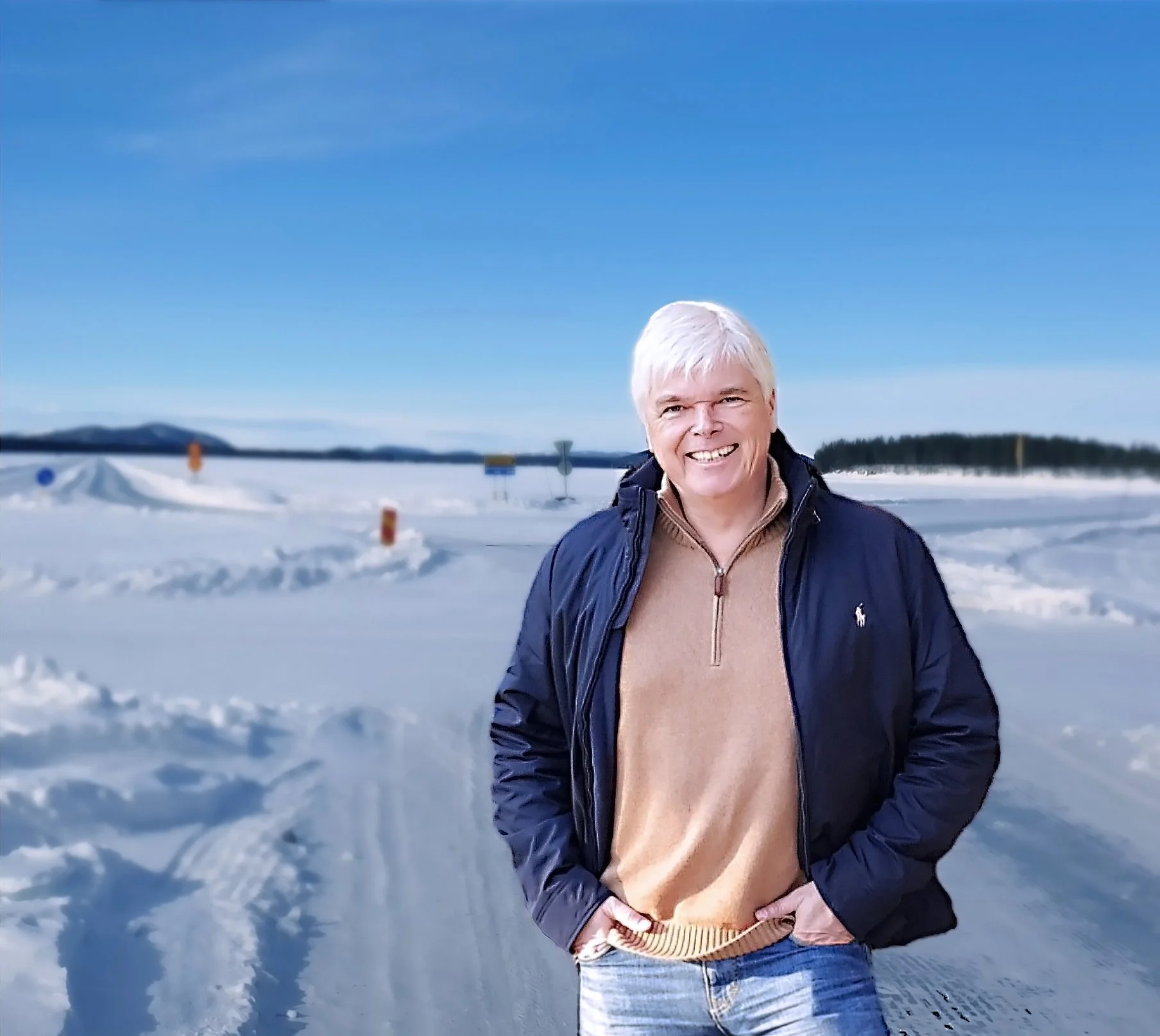
"The customer’s decision always triumphs.»
— Dr. Hans-Jörg Feigel
Parting ways yet remaining partners
The IPGATE/LSP and Continental innovation team parted ways in 2011 after a period of intensive collaboration but continued to interact occasionally until 2013. LSP then cooperated with TRW (formerly ZF) and engaged in other inspiring collaboration journeys. Each company contributed different elements to the invention of the One-Box as we know it today.
The MK C1 project, which ultimately led to the development of the One-Box used today, is a testament to the innovative contributions of IPGATE, LSP and Continental. Each team played a vital role in making this cutting-edge technology a reality.
IPGATE and LSP made significant strides in ensuring extremely fast pressure build-up, independent of the driver’s actions, using EC motors, PPC pressure control and MUX logic in ABS. This innovation allowed for quicker and more responsive braking, which was particularly crucial in the development of automatic emergency braking (AEB). The AEB feature, a life-saving addition, is now the new benchmark in braking systems. It was designed to stop a vehicle automatically in critical situations, such as a rear-end collision caused by driver inattention, by using sensors to detect dangerous driving situations. This was one of the key advancements in LSP's contribution, and it became a vital part of the overall system’s success.
Another crucial contribution from IPGATE and LSP was the development of the Fail-Safe Master Design, which ensured that even women could safely brake in case of system failure. This innovation provided three times more braking deceleration using the foot's natural strength, further making the braking system more universally accessible and safer for everyone.
In addition, IPGATE and LSP introduced fully variable regenerative braking, which utilized high-dynamic and precise pressure control, the PPC control. This allowed for greater braking efficiency, especially in regenerative braking systems, and improved environmental performance by recovering more energy during braking.
While IPGATE and LSP were responsible for the technological advancements that made the system safer, more efficient, and accessible, Continental also brought their own innovations to the table. Dr. Hans-Jörg Feigel and his team at Continental were responsible for developing the ideal packaging, which allowed for a shorter vehicle build and larger crash zones. This innovation enabled the creation of vehicles that were not only safer but also more compact, maximizing the space available for safety features and providing larger crash zones to protect passengers.
The team at LSPContinental also made strides in improving ABS technology by using outlet valve control for faster pressure drop into a reservoir at atmospheric pressure (the so-called open-hydraulic system using the advantage of no counterpressure as typical constraint in conventional ABS-systems), resulting in shorter braking distances. The project was instrumental in shifting the industry's focus from measuring braking distance to focusing on stopping distance, a shift that established a new standard for braking systems. The inclusion of Pedestrian Protection and the successful implementation of Automatic Emergency Braking (AEB) were also key Continental contributions. These systems used sensors to detect critical driving situations, such as the risk of a collision, and automatically activated the brakes to prevent accidents.
Together, the IPGATE, LSP and Continental teams were able to combine their respective innovations, pushing the boundaries of braking technology and ultimately creating a system that was safer, more efficient, and more environmentally friendly. As Valentin Unterfrauner aptly put it, “if you think about it, compared to Continental we were a small player, but Continental truly recognized the value of our contributions and technical expertise. It was all about creating something of real worth, and in the end, the recognition we earned for our innovation was priceless.”
A Shift in How We Think of Vehicle Safety
Continental was the first Tier 1 supplier to industrialize the One-Box innovation, positioning itself as a leader in automotive braking technology. At the time, competitors took different approaches, some of which were successful in their own right. Yet, despite the diversity in solutions, the One-Box’s revolutionary design eventually proved to be the most enduring. Today, variations of the One-Box are featured in one in every three cars on the road, a testament to the breakthrough it represented. By the end of the decade, it's projected that the One-Box, and the related Two-Box, will dominate the market, with electro-hydraulic braking systems becoming the standard in 80% of vehicles by 2030.
“Today, variations of the One-Box are featured in one in every three cars on the road.”
The MK C1 project, which laid the foundation for these innovations, forever changed the landscape of braking technology. It was no longer just about stopping a vehicle—it was about doing so with unparalleled precision and safety. The focus shifted to systems that could respond quickly, adapt to driving conditions, and protect passengers, pedestrians, and drivers alike. The demand for such advanced braking systems has been so high that it has reshaped the industry in profound ways, and this transformation is only beginning.
While the adoption of these systems comes with a price, the value they provide in terms of safety, reliability, and performance has made them an integral part of modern vehicles. The One-Box’s ability to integrate different braking functions, manage pressure build-up with lightning speed, and enhance vehicle safety is a game-changer that has paved the way for the next generation of automotive technologies.
Looking back on the journey, Valentin Unterfrauner reflects with pride: "I’m proud of what we accomplished. We created better brake systems, systems that didn’t just meet the needs of our clients but set new standards in the industry. That’s something I’ll always carry with me."
It’s a statement that speaks not just to the technical achievements of the project but to the lasting impact it has had on the entire automotive sector. The MK C1 and the innovations that followed have not only met the demands of today but have set the stage for the future of safe and efficient driving.
Summary and outlook of One-Box
The invention of the MK C1 marked a monumental leap forward in braking technology, reducing stopping distances by enabling full braking pressure build-up within 150 ms. This achievement is unlikely to be surpassed in the near future. While further improvements are possible, such rapid advancements in braking speed are rare, as any additional increase would affect the entire vehicle’s dynamics. Automatic Emergency Braking (AEB) will become a new industry standard, comparable to ABS/ESC, and has already become indispensable for safety. Stopping distance will replace braking distance as the standard measurement criterion for braking systems.
One of the main drivers for introducing a One-Box System, instead of conventional ESC systems with electromechanical boosters, is its ability to support higher deceleration levels of recuperating e-drives. Because there is no limiting pedal feel implication, the One-Box system optimizes recuperation efficiencies in electric vehicles, contributing to longer driving ranges.
Due to its significant functional and cost advantages, the One-Box Brake system is expected to become the most widely used brake system in new passenger vehicles worldwide by 2030. Braking systems will continue to evolve in the future, for example, with the introduction of dry brake actuators, but the MK C1 has laid the foundation for this by fostering the worldwide acceptance of simulator brake systems.










